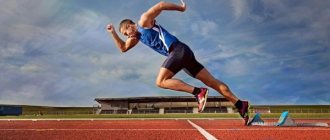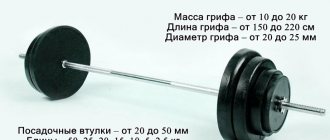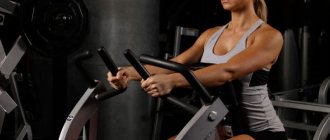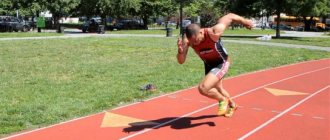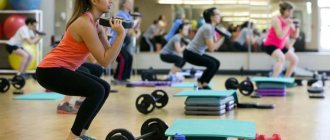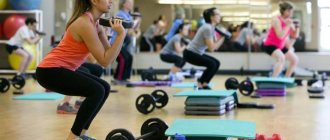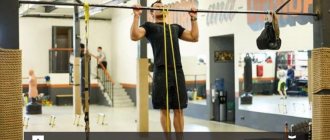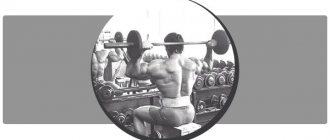Hello my dear readers!
Sprinting or sprinting is a fast form of running competition. The runner wants to give his best in terms of time in order to cover the short distance with the best result.
Did you know? The fastest man on our planet comes from Jamaica named Usain Bolt. And although the title is not official, he covered the 100-meter distance in just 9.58 seconds. Its recorded speed is 37.578 km/h.
The distances at which competitions are held can be as follows: 60, 100, 200, 400 meters. Due to its characteristics, this type of running does not tolerate mistakes.
If the sprinter made technical errors at the beginning or at the end, or interrupted the process, then he loses a split second, but these are the moments that decide everything.
From the point of view of human physiology, this running technique is characterized by oxygen-free (anaerobic) respiration. The sprinter successfully breathes and receives energy from previously accumulated reserves.
It is also worth noting that the main technique of sprinting is to lift your leg and push it away from the track, that is, such running is power-oriented.
Important! If you suddenly decide to go for a run, but haven’t had good sports training, then start it yourself. Otherwise, problems may occur in the muscles, ligaments, and your heart, blood vessels and respiratory system will be in danger.
Sprint distances
It’s safe to say that the most popular distances are 100 and 200 meters. It's funny, but some people don't see their colleagues at all. Range varies from 60 to 400 meters
Standard distances are 60, 100, 200, 400 meters, and the above-mentioned relay race also takes place. All of them are included in the Olympic Games program, with the exception of the regular 60-meter race. Competitions in this discipline are held only indoors.
Table No. 1. Sprint
Winter disciplines (take place indoors)
Summer disciplines (take place in open stadiums)
Non-standard distances (not approved by the IAAF)
| 1 | 60 meters | 100 meters | 30 meters |
| 2 | 400 meters | 200 meters | 50 meters |
| 3 | 4x400 meters relay | 400 meters | 150 meters |
| 4 | 4x100 meters – relay | 300 meters | |
| 5 | 4x400 meters – relay | 500 meters | |
| 6 | 4x200 meters relay |
* IAAF - International Association of Athletics Federations
Competitions at non-standard distances can be organized at various regional and amateur competitions. International Athletics does not take into account documents and results presented at these competitions.
At most sprint distances, black athletes hold the lead. This is due to their genetics. But Russian athletes have several world records behind them. For example, Ira Privalova has been the current world champion in the 60 meters since 1995.
In fact, athletes train differently at each distance. In fact, preparation for competitions at 60, 100, 200 meters is similar. Usain Bolt's 100-meter record race can serve as confirmation.
When he completed the 100m race in 9.58 seconds, he covered 60m in 6.31 seconds. Surprisingly, the official world record for 60 meters is 6.39 seconds. For certain reasons, Bolt's 60m time was not officially included in the record table. The two-hundred-meter world record also belongs to the Jamaican legend.
Not only the methods of preparing for certain distances differ, but also the running technique. This mainly applies to 400 meter races, as running at this distance is more difficult than 60, 100 and even 200 meters.
Among athletes there is a concept called a long sprint. In particular, this definition is usually used to call a distance of 400 meters. Among men at this distance, black athletes are again the favorites, but women have set global records for athletes - the Euro - in the last century.
Features of sprint running
- To cover the distance within the specified time, the athlete must activate all his physical and emotional strength. The race always shows great performance, sprinters cannot afford to relax even in training;
- Insane speeds don't mean you can neglect your running technique, the same principles apply here as for other disciplines;
- Coordination of movements plays an important role in sprinting, as does the level of resistance;
- Sprinting, successfully and without harm to health, is possible only for those people who are in good physical shape.
The benefits of sprinting
Sprinting is a race to the limits of your own body. Many people believe that it is a waste of the body, but it has many benefits. Here are some of these facts:
- Huge stimulation for the heart;
- Adrenaline rush after completing the distance;
- You can significantly reduce body weight;
- There are high-speed resistance exercises that are necessary not only for runners, but also for athletes in long and high jumps, as well as in all team sports.
Distance must be calculated for all runners. After all, during it there is a main struggle for championship. In addition, sprinting teaches you to focus on the long distance.
For runners, it is best to start your sprint training by alternating between running and jogging or very fast walking.
Run fast to cover the sprint distance at high speed. This is negative for the body, because there is a huge load on the heart. But you can get good results in the form of increased speed running endurance.
Athletics
Sprinting is characterized by maximum intensity. The runner strives to reach maximum speed in the shortest possible time and then maintain it. Therefore, not only the actual running along the distance, but also the technique of starting and starting acceleration is of great importance here. Start and starting acceleration. In sprinting, a low start is used. The runner pushes off from special pads
installed in front of the starting line. Starting blocks allow you to create a good support for your feet, increase the take-off point and maintain a significant torso tilt during the starting acceleration. The runner rests the entire sole (all the cleats) of the running shoes on special support platforms, which are installed at a certain angle of inclination depending on the individual characteristics of the athlete. Typically, the installation angle of the front pad is 45°, and the rear pad is 60 - 70°.
Currently, most of the strongest runners use a “regular start”, placing the blocks like this: the first block is placed approximately 1.5 feet from the starting line (about 40 cm), and the back block is placed in front of it at a distance equal to the length of the shin (about 45 cm). The distance between the pads is equal to the width of the foot. In each individual case, deviations are possible depending on the individual characteristics of the runner, but, as a rule, they are insignificant. For tall, long-legged runners, it is more convenient to place the blocks a little further from the starting line, and for short runners with great strength, the starting blocks can be somewhat closer and moved towards the starting line. Placing the blocks in a normal start allows you to quickly teach the athlete how to correctly perform running movements from the start and almost eliminates jumping from the blocks.
According to the rules of sports competitions, the signal to start running is the command “March!” or a pistol shot. These commands are preceded by two preliminary ones: “To the start!” and “Attention!” At the command “Start!” the runner approaches the pre-installed blocks and stands in front of them. Leaning forward, he rests his hands in front of the starting line, places his strongest leg on the front block, and his weaker leg on the back block. After this, the runner lowers the knee behind the standing leg to the ground and moves his hands to the starting line: four fingers are joined together and turned outward, thumbs inward. The width of the arms on the ground is equal to the width of the shoulders, the shoulder joints are located above the starting line. As you master the starting technique, you can further move your shoulders forward beyond the starting line by 5-10 cm. The weight of the body is distributed almost evenly between the support points. The head is held freely, the gaze is directed forward and down approximately 1-1.5 m from the start line (in the figure, frame 1).
At the command “Attention!” the runner, without changing the position of his hands and continuing to rest his feet on the starting blocks, raises his pelvis and moves his shoulder joints forward beyond the starting line; The back in this position is straight or slightly rounded. It is important to bring your shoulders forward so that you can maintain your difficult balance. At the same time, you should not unnecessarily transfer the weight of your body onto your arms—the time between the signal to run and the start of running will increase, and this will also affect the final result of running.
If the runner commands “To the start!” brought his shoulders forward, then at the command “Attention!” it will only raise the pelvis (the projection of the centers of the shoulder joints will always be behind the starting line). In this case, loss of balance rarely occurs. When on the command “Attention!” The runner moves his body forward and raises his pelvis, but often loses his balance and runs out from the start before the signal. In the position occupied by the command “Attention!”, it is important to raise the pelvis to a certain height. For beginning runners, the pelvis should be raised slightly higher than the shoulders (frame 2). With the development of strength and speed, the position of the pelvis changes - the back takes a more straight position, that is, the pelvis will not rise higher than the shoulders, the bending angles of the legs will become sharper, and the runner will be able to push off harder from the blocks.
Approximately 2-2.5 seconds. the runner, having stopped all hesitation, waits for the last command - “March!” You need to command sharply and loudly, you can also imitate a pistol shot. It is very important from the very beginning of training to ensure that runners start running only on command and do not learn to start it prematurely (the so-called “false start”).
Hearing the command “March!”, the athlete sharply lifts his hands off the ground (frame 3) and with a strong swing (one hand forward, the other back) advances the movements of the legs. This helps you push off the blocks more powerfully (frame 4). The leg standing behind pushes off the block earlier and begins to move the knee forward while the other leg continues to push off. The leg standing on the front block is fully straightened by the time the thigh of the other leg is brought forward to the limit (frame 6); The torso, straightening, moves forward and takes a position close to horizontal (frames 4 and 5).
All movements from the start must be strictly coordinated. The position of the head also matters. Thus, a sharp movement of the head back contributes to premature straightening of the body, and pressing the chin to the chest leads to a significant bending of the back, trampling in place.
The first step from the start is taken with the swing leg (standing on the back block), which is placed on the track with the foot down and back, the toe of the foot is taken over at this time; the foot is placed on the ground quickly and elastically, but not with an impact (frame 6).
The running speed increases gradually and approaches the maximum possible - a 20-meter distance. The length of steps during acceleration increases as follows: 1st step (measured from the front starting block to the front edge of the track) -3.5 feet; 2nd step (measured from the front border of the footprint of one foot to the front border of the footprint of the other)—3.5; 3rd - 4-4.5; 4th - 4.5-5; 5th - 5 - 5.5 feet.
During the starting run, the foot is placed on the ground from the toe, and later on the forefoot. The footprints of the feet should be located along two lines, which are connected into one by the 5th-6th step, and then running occurs in one straight line. The foot places itself on the ground with the toe directly forward or slightly inward. The starting acceleration ends when a relatively constant stride length and torso are established. takes a position close to vertical.
Beginning runners often experience a sharp straightening of the torso at the 2nd or 3rd step. This leads to “stomping” in place, i.e., to a delay in the increase in speed.
For the strongest sprinters, the starting acceleration ends at 22-24 m; at this mark the runner’s speed is close to maximum, and it reaches its maximum in the middle of the 100-meter distance. Running the distance. During the distance, the achieved speed is maintained until the end of the run. But achieving this is not so easy, since by the end of the distance fatigue increases, which may result in a violation of the coordination of the runner’s movements, i.e., a change in running technique.
In the running step (in the picture, frames 1 and 5), the thigh of the swing leg rises to an almost horizontal position. Push-off is carried out by straightening the leg at the hip, knee and ankle joints (frames 5 and 8). Great importance must be attached to the final push off of the foot from the ground. This movement promotes full straightening of the leg at the knee joint and is of great importance for maintaining high running speed.
After repulsion, the flight phase begins: the pushing leg bends at the knee joint, the shin loosens somewhat and rises up (frames 2 and 6), the thigh of the pushing leg moves forward, and the swing leg moves towards it, which extends at the knee joint and lowers the foot down. At this moment, the hips are brought together, the so-called “scissors” (frame 6). The swing leg should be placed on the forefoot (frame 7) as close as possible to the projection of the o. c. t. t. (general center of gravity of the body) of the runner, moving backward relative to the body. The more correctly the foot is placed on the ground, the less braking effect this position will have on moving forward.
The runner makes a “raking” movement down under himself, which is a continuation of the counter movement of the hips. If this counter-movement (“scissors”) is weakly expressed, then the foot will be placed on the ground at a more acute angle (the shin “slaps forward”). With this position, the foot seems to “bump” into the ground, placed far forward from the projection of the o.c.t. body, which leads to significant braking of the athlete’s body and a loss of running speed.
The runner does not pull the toe of the foot down, but elastically touches the ground with all the spikes almost simultaneously and lowers almost the entire foot. At this moment, the leg, like a spring, instantly lowers onto the entire foot and elastically rises to the toe.
The knee of the free leg sweeps near the supporting leg, which bends at the knee joint. The shin of the fly leg occupies a position close to vertical, the heel almost touches the buttock (frames 3 and 7). Strong flexion of the swing leg promotes rapid movement of the hip forward and upward (frames 7 and 8). The position in which the knee of the swing leg passes near the knee of the push leg is called the vertical moment (frame 3). Good running technique at the moment of vertical is characterized by two main elements - at the moment of “vertical” the knee of the swing leg is slightly lower than the knee of the supporting leg, and the heel of the swing leg almost touches the buttock. This indicates good relaxation of the main muscle groups. Active extension of the pushing leg begins after the vertical moment. The correct direction of take-off also depends on the position of the runner’s torso. It should be tilted forward and slightly arched at the lumbar part (frames 1-4) to facilitate moving the pelvis forward (frame 5). A good take-off is characterized by full straightening of the pushing leg, the thigh of the swing leg is raised almost to a horizontal position, and the lower leg is parallel to the thigh of the pushing leg.
Arm movements while running help maintain balance and maintain or change the pace of movement. Moving forward, the arm, strongly bent at the elbow joint, reaches the midline of the chest, the hand does not rise above the chin. In this case, the hand drags along the body, which rotates around a vertical axis, bringing forward the shoulder of the same name as the hand. Synchronized movements of the torso and arms allow you to more actively move the thigh of the swing leg forward. During the reverse movement, the elbow moves straight back. Half-bent hands are relaxed.
The stride length in sprinting is longer than in long-distance running. For the strongest male runners it is 7.5-8.5 feet, for women - 7-8 feet. This is approximately 200-240 cm and 180-220 cm. Less skilled runners have a much shorter stride length (by 30-40 cm), but this does not mean that a runner should strive to artificially “stretch” their stride. The latter will lead to enslavement and reduced speed. The stride length increases with the development of the runner's strength under the influence of special and general developmental exercises.
Of great importance in running is the runner’s ability to eliminate excessive muscle tension. During short-distance running, the athlete experiences great nervous tension, so significant excitement is possible, which leads to stiffening of muscles not involved in work (this is often expressed in convulsive facial grimaces, raising shoulders, etc.), and to a decrease in running speed .
Finish acceleration and throw to the ribbon. Finishing - the end of a run - involves the final effort to maintain maximum running speed towards the end of the distance. This effort (volitional and physical) occurs in the last 20 m of the distance. If the runner finishes . distance without a serious fight for a place in the race, then he, without making a throw at the ribbon, runs through the finish line, maintaining the technique of running along the distance. If there is intense competition in the race, then in order to touch the finish line with your chest earlier, you have to make a throw, which allows your chest to cross the finish line a few hundredths of a second earlier than when running without a throw. Throwing onto the ribbon is performed in two ways: chest and shoulder.
Approaching the finish line, the runner (1 m before the ribbon) sharply leans his chest forward at the moment when his foot is on the ground (as shown in the figure). In another method, the runner, simultaneously with a sharp tilt of the body, turns forward the shoulder opposite the supporting leg, trying to touch the ribbon with it.
Stop after the finish. A novice athlete should know that when throwing on the ribbon, a fall is possible. To prevent it, you need to sharply move your swing leg far forward, whipping your shin - the athlete seems to “bump into” his leg and at this moment strives to straighten up. In subsequent steps, the runner straightens his torso, and then gradually tilts it back and switches from running to walking. After running the distance, the athlete should not immediately sit down and lie down. He needs to walk around, regain his breathing, and then get dressed and rest.
Some features of the 200m run
The 200 m run differs from the 100 m run not only in the increased distance, but also in the fact that the first half of the run is carried out along a turn.
When running around a turn, the runner overcomes the centrifugal force, which is directed from the center of the circle. Countering this force, the runner leans heavily inward of the circle (i.e., to the left). Therefore, the movements of the arms change somewhat—the right arm, moving backward, is moved to the side by the elbow, and when moving forward, it is moved more inward. The left hand, moving forward, moves the hand more outward. When running around a turn, foot placement is of great importance. The left foot should point outward, and the right foot should point slightly inward (i.e., to the left). In short-distance running, each runner runs along his own track, trying to be as close as possible to the edge (to the inside line). If you run in the middle of the track or near its outer line, the distance increases. Good sprinters run about 10 cm from the line. But it is important to remember that you cannot run along the white line or run beyond it, since in this case the distance is reduced and the result shown to the athlete is not protected. In the 200 m race, the starting technique changes somewhat. The starting blocks are placed at the outer edge of the track, and so that their supporting surfaces are directed slightly to the left. Then the runner's right shoulder will move forward, and the left hand will be 10 cm from the start line. This will allow you to run part of the turn in a straight line and help you enter the turn smoothly. The higher the speed, the more the runner tilts his torso inward, since he has to overcome greater centrifugal force, and this requires the application of certain efforts. Fighting centrifugal force causes significant muscle tension, which can persist even when running in a straight line. To prevent this from happening, when entering the straight line, the runner straightens up very smoothly and runs without bending inward. When exiting a turn, the sprinter uses what is called a “freewheel” or coasting (without making any effort to increase speed). This type of running is carried out over a distance of about 8-10 m (4-5 running steps). After 2-3 years of training, with increasing training, it comes down to 2-3 running steps. This run is carried out at the end of the turn in the segment between PO-115 m of the distance (depending on which track the athlete is running on). After the “free run”, the runner again engages in active work and strives to maintain a high speed for himself in the second half of the distance. The average speed of the world's strongest runners in the 200m is higher than in the 100m because the second 100m is run running. Beginning runners should aim to run 200m in twice the time they took in the 100m.
Some features of the 400m run
The technique of running 400 m is almost no different from the technique of running shorter distances. The start is made at the turn, the run begins just as quickly, but somewhat freer. The starting acceleration does not require maximum voltage and ends somewhat earlier. The torso in the 400m run is closer to a vertical position. The step is somewhat shorter (7-8 feet). In the 400 m race, the athlete’s ability to maintain correct technique in the face of progressively increasing fatigue is of great importance. In the last quarter of the distance, severe fatigue sets in, and running speed decreases due to a reduction in step length. Therefore, a runner must be able to change the running rhythm in time - increase the frequency, thereby compensating for the decrease in step length. At this distance, it is important to be able to start running at the optimal speed. Trained runners usually run the first 200m very easily. This is facilitated by good loosening of the runner, a slightly reduced stride length and a certain reserve of speed. In the 400m sprint the average speed is lower than in shorter distance runs. Thus, the USSR record holder Nikolai Yushmanov from Leningrad ran 100 m in 10.1 seconds, and 400 m in 46 seconds, while his average speed over hundred-meter segments was 11.5 seconds. True, the runner could not maintain such an average speed over the entire distance: he ran the first segments faster, and the subsequent ones slower. As a rule, the higher the result shown by the runner, the smaller the difference in the speed of running the first and second half of the distance. This difference reaches 1 - 3 seconds.
The world record in the 100 meters was set by Usain Bolt of Jamaica on August 16, 2009, running the 100 meters in 9.58 seconds.
‹ Running technique Up Relay running ›
Contraindications for sprinting
Improve the health and performance of all muscle groups: that's what this athletics offers. Sprinting is recommended for all beginning athletes. The peculiarity of distance running is that the blood does not have time to create a complete environment for the body to deplete due to this load.
Contraindications for sprinting exercises are skeletal disorders (for example, scoliosis) or heart diseases, such as:
- Congenital heart defect,
- venous insufficiency,
- thrombophlebitis,
- mitral valve stenosis.
In addition, people cannot exercise if they have colds or exacerbations of diseases.
Sports exercises during ARVI are contraindicated, as this is fraught with complications.
How many meters is considered a short distance in running?
The athletics discipline requires good coordination of movement and has a positive effect on the anthropometric parameters of the body . Races are carried out at 30, 60, 100, 200, 300 or 400 m. Such distances are considered short according to the rules of this sport.
The athletic process consists of several successive stages:
- start;
- acceleration;
- overcoming a given segment of space;
- finishing.
Sprinting is a competition that starts from a low start . This technique allows you to accelerate in the initial phase and give the body the proper impulse. According to the classification approved by the IOC and the International Association of National Athletics Federations (IAAF), the 100 m race is considered a classic Olympic standard.
Further short distances are distributed as follows:
- 30 m is a typical standard for school physical education lessons;
- 60 m – race for indoor athletics complexes and gyms;
- 200 m – Olympic distance used at the World and European Athletics Championships;
- 300 m – distance for individual or complex competitions;
- 400 m is the maximum short distance included in the program of the Olympic Games.
A long sprint is a 400-meter distance. This is a highly specialized and complex sports discipline that requires great endurance with the utmost power of speed work.
The benefits of sprinting
- reaction speed and strength develop. Sprinting should be started at a young age and in adulthood, but should be eliminated in old age and old age, since the heart and blood vessels receive a huge load;
- running at high speed over short distances uses a huge number of muscle fibers and allows you to burn a lot of calories;
- allows you to strengthen your legs and buttocks, because explosive movements intensively engage deep muscle areas;
- sprinting develops your respiratory system because the high workload forces you to consume huge amounts of oxygen, which in turn increases your lung capacity.
If you have never practiced sprinting before, you need to start gradually. Start by jogging 200-400 meters and work your way up from one activity to the next. This is the only way you can reduce the distance and increase your running speed.
For example, run 400 meters a day for 1 week, decrease the distance to 350 meters for 2 weeks and then decrease the distance by 50 meters for a week and quickly increase your speed.
Mistakes while running
Shifting the straight leg forward
Beginning runners often don't bend their legs enough as they move forward. Having pushed off the surface, the leg is carried almost straight, with a slight bend in the knee.
With the correct running technique, after the push, the leg bends quite strongly at the knee (how much depends on the runner’s task), moves forward in a bent state and straightens only during the downward movement.
Transferring body weight to the foot when it is in front of the knee
Above is a good example of incorrect running technique, when the body weight is transferred to an almost straight leg brought forward.
When you transfer your body weight to your foot, it should be directly under your body. If you rest on your foot before it is under your center of gravity, your running speed will decrease and the load on your knee joint will increase.
Sprinting technique
Despite the rather short distance, the sprint can be divided into 4 consecutive stages. Each step must be performed strictly according to the methodology. These are steps like:
- Start
- Overclocking
- Basic distance running
- Finish
You should always start the race with a small start. This position helps to regroup before the start of the race, as well as mobilize internal energy. Stronger leg in front, hands shoulder-width apart.
When commanding “attention”, it is necessary to move the center of gravity forward, raising the pelvic part to shoulder level. When whistling, there is a strong repulsion from the bearings with parallel activation of the upper limbs. You need to move your arms just like your legs. If you did it correctly, you will be able to accelerate very quickly. While running, your arms must be bent at the elbows.
The second stage, which is usually around 30 meters, requires the athlete to establish a high speed, which must then be maintained until the last line. Acceleration is achieved by increasing the frequency and length of the step.
It is more convenient to accelerate by keeping your body tilted forward. This position will accelerate better. When the speed begins to increase, the body should gradually straighten. The speed of the runner is very important here, as well as the inertia that was achieved in the first few meters after the start.
High speed can be achieved by the 6th second of the race, and after the 8th second the speed begins to gradually decrease. These figures do not depend on the runner’s age, qualifications or level of training.
In the last stage, when the finish line is close enough, the runner must remain calm. To show a high result, you need to complete the race at maximum speed. Some people think it's better to finish a race with a big jump to get to the finish line faster. But this opinion is wrong.
A person should always slow down a little before a jump, and during a sprint race this will waste precious seconds before the finishing line. It is recommended to finish your run with your shoulder or chest slightly forward, but for beginners this technique may seem quite difficult.
How to Improve Your Running Technique
It is important to hone each element individually and everything together until it becomes automatic. During training, significant attention should be paid to the amplitude of swing movements of the legs. Athletes learn to control body position in space, correct body tilt, and achieve precise arm swings.
The main load falls on the muscular systems of the lower extremities . They need to be strengthened and comprehensively developed to achieve the best sports results. Running on rough terrain, interval exercises, and jogging will help. To develop speed characteristics, track and field athletes play football and basketball during training.
Increasing the frequency of steps is facilitated by running on the spot with high knees. An important place in the training process is occupied by increasing muscle elasticity. This increases the length of your running stride. Practice proper breathing techniques.
Exercises to improve results
A key training technique for sprinters is running in place with high knees . To practice each element there is its own set of exercises. The starting technique is honed through repeated repetition. It is recommended to perform the “Attention” command at least 8 times during each training session.
Sprinting technique is improved by running as quickly as possible in segments of 60-80 m. From a low start in training, distances of 30, 40 and 60 m are covered. To improve speed characteristics, they run downhill for 50 m. Turning technique is practiced by inclined running for short distances.
The basic exercise with high knees while running in place is performed 3-5 approaches during the workout with limits of 20-30 seconds. To practice the finishing technique, the correct inclination of the body with the arms moving behind the back is repeatedly practiced in statics and dynamics.
Proper nutrition and breathing technique for sprinting
To achieve good sports results, it is important to saturate the body's cells with oxygen. Combining abdominal breathing with normal breathing improves blood circulation. This allows you to maintain maximum functionality of the body throughout the entire distance.
The recommended rhythm of breathing movements is 3:3. The technique is practiced in training and involves performing 3 running steps with the left leg while inhaling, then the same number with the right leg while exhaling. This allows the lungs to capture the maximum volume of atmospheric air.
Before starting, you should not take a sharp breath or exhale. Otherwise, at maximum speed while covering the distance, oxygen starvation may occur. During a sprint race, the lungs' consumption of atmospheric air increases by 2 times compared to a stayer's technique.
One of the most universal ways to increase the functional capabilities of athletes’ bodies is a properly composed diet.
To cover the energy costs associated with the training process and competitions, a sprinter requires a daily diet of 4-5 thousand kcal. For plastic, metabolic and intracellular reactions, the qualitative composition of the food consumed is important. A sprinter's body should receive 2-2.5 g of protein per kg of body weight every day. It is important to maintain proper carbohydrate balance.
These chemical compounds are included in the structure:
- adenosite triphosphate, which plays a key role in material metabolism;
- nucleic acids;
- hormonal compounds;
- protein proteins.
The main function of carbohydrates is energy supply . The nutritional plan is developed individually for each athlete, depending on his physiological characteristics, upcoming competitions and sports specialization. The 100, 200 and 400 m races require a different approach to diet planning.
Sports nutrition manufacturers produce special vitamin-mineral complexes and nutritional supplements for short-distance runners. This allows you to achieve an effective impact on the physiological parameters of the body without violating anti-doping rules.
Improving sprinting technique
Improvement occurs due to an increase in speed and power load on the athlete. At the same time, the correct line of movement is refracted. The athlete also tenses muscle groups that he does not use in running. To make changes to the technique, we did a special set of exercises.
Premature training in a sprint race from a small start had a negative impact on the technique of such a sport as short-distance racing. The exercises used by coaches to correct technique normalize the functioning of various muscle groups and joints, regardless of how old the athlete was in initial training as a child.
- An excellent exercise is sprinting.
- Accelerated running is used on tracks with a large radius.
- To improve technique, a variable stroke is used from a larger start to a smaller one.
- Team test. During this exercise, the athlete's concentration and ability to relax are important.
- Development of running ability from the initial jump to long-distance running.
- Low start work. Close your initial position. Practice the correct final run.
- There are two ways to properly cross the finish line: chest and shoulder - both positions allow you to fine-tune your sprinting technique.
Adjustments include racing on an inclined track and working on simulators. The athlete covers the distance at three-quarters of his strength. And even running with acceleration occurs at maximum speeds.
Excellent activity - running exercises on an inclined track, this increases resistance to stress
Tips for 100m dash performance
Workout
Mastering the sprint technique, as in any sport, is impossible without fundamental general and special physical training.
General physical training lays the foundation for the body to function under extreme loads (the 100m sprint is just such a case), and special physical training is aimed at developing specific muscle groups and such sprinter qualities as strength, coordination, speed, speed endurance, and jumping ability. Along with them, tactical and psychological preparation accompany the athlete throughout his entire career.
The greatest effect is achieved by the method of interval training, when a period of intense exercise is followed by a period of recovery.
Visually, the apparent ease of running of a highly qualified athlete defeating his opponents speaks of high technique that hides a truly titanic load - the heart rate can exceed 200 beats per minute, and blood pressure increases significantly.
Warm-up
The warm-up models of a beginner and an experienced sprinter differ radically. If for the first one the standard warm-up of an athlete is sufficient, then the master includes a certain set of exercises in the set of exercises.
As a rule, warm-up begins with various running exercises, excluding long running (short easy jogs of 40-50 m, running with a high hip lift, sweeping the shin back, mincing running with a transition to acceleration, etc.), stretching exercises for various muscle groups , swinging, rotational movements, bending.
Next, move on to the jumping part (standing, triples, jumps on one leg) and return to running again (changing the tasks of the first part of the running tasks). The warm-up part of the workout ends with short runs with smooth acceleration, but not at full speed.
Assistive exercises
To improve their sprinting technique, athletes perform simple but effective exercises:
- Jump out of a squat.
- Jump from a lunge by changing the position of the legs.
- They jump on each leg in turn. Try to jump very high, as if something is suspended from the highest point.
- Sprint overcoming obstacles of a certain height. They are arranged in a 60 cm checkerboard pattern. You must jump over them in such a way as not to intersect, and the height of the obstacles must gradually increase.
- Running with jumping. With every step, big jumps are made. Aim to increase the length and height of your stride.
- Jump rope.
To increase your sprint speed, train with intervals. They include alternating short distance running: 10-12 steps at high speed and the same number of steps without haste, and so on in a circle.
After a 400-500 meter race, rest for a few minutes, but don't let your muscles relax.
Average level. On average, 25,000 ₽ per month
When a sprinter starts competing, the training process changes. This is a transitional stage from promising athletes to a professional sports career.
For an amateur to actively travel to competitions, train, and go to training camps, he needs additional expenses. At this stage, the state remains on the sidelines - start showing better results and there will be support.
Financial support from the state appears when a sprinter performs well at the Russian Championships and gets into the final race. The conditions for paying wages in the regions are different, but if a sprinter takes a prize in his distance or in a team relay, he can count on a monthly salary.
Equipment:
- 4-5 T-shirts (5000 rubles) - shorts (2000 rubles) - 2 pairs of tights (7000 rubles) - 2 pairs of sneakers (9000 rubles) - winter clothes (8000 rubles) - spikes (3000 rubles) - additional expenses (3000 rubles )
Different price categories of goods:
| Summer things - 2500 ₽ | Summer things - 5000 ₽ |
| Sneakers — 2900 ₽ | Sneakers — 9300 ₽ |
| Men's tights - 800 ₽ | Men's tights - 5400 ₽ |
| Spikes - 3000 ₽ | Spikes — 6000 ₽ |
Some athletes already at this stage buy sports nutrition - about 10 thousand rubles per month. About the same amount is needed for recovery: massage, ointments, tapes, sauna.
Don't forget about strength training. This is an optional expense and depends on your options for where you can exercise. But on average, going to the gym will cost at least 5,000-8,000 rubles for six months. You can add the same amount to this amount if you work with a personal trainer.
Sprinting - standards
The rules of the Russian Federation are quite complex. It is impossible to run them without preparation. To increase the level of physical culture among the population of the Russian Federation, GTO standards were adopted, which are not so strict.
The difficulty of meeting the standards is explained by the fact that the sprint distance is a classic one, and its technique has been studied and improved. The experience and potential of modern athletes have given such standards.
At the same time, an ordinary person will not be able to compete for the title of master of sports, since sprinters spend a huge number of hours on treadmills and in gyms to achieve the standards.
Table of norms for men.
| Discipline | Master of Sports of International Class | Master of Sport | Candidate Master of Sports |
| 100-meter run (seconds, tenths and hundredths of seconds) | 10,28 | 10,64 | 10,94 |
| 200m sprint | 20,75 | 21,34 | 22,24 |
| 4000m run | 45,8 | 47,35 | 49,65 |
Table of standards. Women.
| Discipline | Master of Sports of International Class | Master of Sport | Candidate Master of Sports |
| 100-meter run (seconds, tenths and hundredths of seconds) | 11,32 | 11,84 | 12,54 |
| 200m sprint | 22,92 | 24,14 | 25,54 |
| 400m run | 51,21 | 54,05 | 47,15 |
The standards for athletes who are not masters of sports are softer. But it’s beyond the reach of an ordinary person.
Table of norms for men.
| Discipline | I category | II category | III category |
| 100m run (minutes, seconds, tenths and hundredths of seconds) | 11,44 | 12,04 | 12,94 |
| 200m sprint | 23,24 | 24,44 | 25,84 |
| 400m run | 52,15 | 56,15 | 1,00,15 |
Table of standards. Women. Discipline
| Discipline | I category | II category | III category |
| 100-meter run (minutes, seconds, tenths and hundredths of seconds) | 13,24 | 14,04 | 15,04 |
| 200 meter dash | 27,04 | 28,74 | 31,24 |
| 400 meter run | 1,01,15 | 1,05,15 | 1,10,15 |
The greatest prospect of exceeding sprint standards is for people who are prepared in accordance with the GTO standards. For exceeding - silver, gold and bronze medals.
GTO standards for children (60 meters).
| Age | Boys | Girls | ||||
| Gold | Silver | Bronze | Gold | Silver | Bronze | |
| 9-10 years | 10,5 | 11,6 | 12 | 11 | 12,3 | 12,9 |
| 11-12 years old | 9,9 | 10,8 | 11 | 10,3 | 11,2 | 11,4 |
| 13-15 years old | 8,7 | 9,7 | 10 | 9,6 | 10,6 | 10,9 |
| 16-17 years old | 13,8 | 14,3 | 14,6 | 16,3 | 17,6 | 18 |
GTO standards for adults (100m).
| Age | Men | Women | ||||
| Gold | Silver | Bronze | Gold | Silver | Bronze | |
| 18-24 years old | 13,5 | 14,8 | 15,1 | 16,5 | 17 | 17,5 |
| 25-29 years old | 13,9 | 14,6 | 15 | 16,8 | 17,5 | 17,9 |
Top-class athletes reach maximum speed at a distance of 60 meters.
The popularity of sprinting is due to its speed, dynamism, passion and satisfaction from the results achieved. Sprinting is the ability to win at the limits of the body's strength and capabilities. Athletes can cover the distance faster and achieve excellent results.
High launch and acceleration in a straight line
A high start is ideal for non-professional runners, as it does not impair coordination and does not require specific skills, unlike a low start.
For a high start, the athlete places the starting foot on the block directly in front of the start line. The swing leg parallel to the push leg is placed behind the forefoot. As soon as the “Attention” command sounds, the weight of the entire body moves to the pushing leg.
Arms bent at the elbows are placed in front of the starting line. The hand opposite the pushing leg is slightly in front. The first few meters the body remains inclined, gradually straightening as it accelerates. During this distance the athlete reaches maximum running speed.
When accelerating in a straight line, there are two types:
- rolling out;
- power.
Rolling out
In this type of acceleration, acceleration is carried out using the foot and knee. The body is strongly tilted forward and the legs seem to catch up with the body.
This take-off run is good because it requires minimal effort and a fairly quick increase in speed.
Power
During power acceleration, the main load falls on the foot and back of the thigh. Therefore, with this type there is a possibility of damaging the thigh muscles. Power acceleration is used for short distances.
High launch and acceleration on turns
The tilt of the body during acceleration along a turn depends on the speed of the athlete and the radius of the turn. When accelerating, the body is tilted forward and directed along the turning arc. The feet are directed towards the side of the turn. The hand on the opposite side of the turn works much wider than the hand going along the turn.
After 20-30 meters, the body is completely straightened and running posture is restored.
